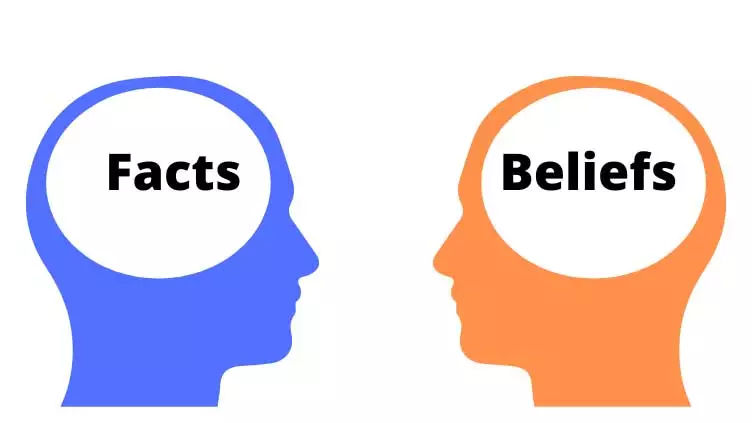ISLAMABAD, Sep 12(ABC): Cognitive dissonance is the discomfort a person feels when their behavior does not align with their values or beliefs. It can also occur when a person holds two contradictory beliefs at the same time.
Cognitive dissonance is not a disease or illness. It is a psychological phenomenon that can happen to anyone. American psychologist Leon Festinger first developed the concept in the 1950s.
Read on to learn more about cognitive dissonance, including examples, signs a person might be experiencing it, causes, and how to resolve it.
A note about sex and gender
Sex and gender exist on spectrums. This article will use the terms, “male,” “female,” or both to refer to sex assigned at birth.
What is cognitive dissonance?
Cognitive dissonance occurs when a person holds two related but contradictory cognitions, or thoughts. The psychologist Leon Festinger came up with the concept in 1957.
In his book A Theory of Cognitive Dissonance, Festinger proposed that two ideas can be consonant or dissonant. Consonant ideas logically flow from one another, while dissonant ideas oppose one another.
For example, a person who wishes to protect other people and who believes that the COVID-19 pandemic is real might wear a mask in public. This is consonance.
If that same person believed the COVID-19 pandemic was real but refused to wear a mask, their values and behaviors would contradict each other. This is dissonance.
The dissonance between two contradictory ideas, or between an idea and a behavior, creates discomfort. Festinger argued that cognitive dissonance is more intense when a person holds many dissonant views, and those views are important to them.
Signs of cognitive dissonance
It is not possible to observe dissonance, as it is something a person feels internally. As such, there is no set of external signs that can reliably indicate a person is experiencing cognitive dissonance.
However, Festinger believed that all people are motivated to avoid or resolve cognitive dissonance due to the discomfort it causes. This can prompt people to adopt certain defense mechanisms when they have to confront it.
These defense mechanisms fall into three categories:
• Avoiding: This involves avoiding or ignoring the dissonance. A person may avoid people or situations that remind them of it, discourage people from talking about it, or distract themselves from it with consuming tasks.
• Delegitimizing: This involves undermining evidence of the dissonance. A person may do this by discrediting the person, group, or situation that highlighted the dissonance. For example, they might say it is untrustworthy or biased.
• Limiting impact: This involves limiting the discomfort of cognitive dissonance by belittling its importance. A person may do this by claiming the behavior is rare or a one-off event, or by providing rational arguments to convince themselves or others that the behavior is OK.
Alternatively, people may take steps to try to resolve the inconsistency. It is possible to resolve cognitive dissonance by either changing one’s behavior or changing one’s beliefs so they are consistent with each other.
Examples of cognitive dissonance
Some examples of cognitive dissonance include:
• Smoking: Many people smoke even though they know it is harmful to their health. The magnitude of the dissonance will be higher in people who highly value their health.
• Eating meat: Some people who view themselves as animal lovers eat meat and may feel discomfort when they think about where their meat comes from. Some researchers refer to this as the “meat paradox.”
• Doing household chores: A male might believe in equality of the sexes but then consciously or unconsciously expect their female partner to do most of the household labor or childrearing.
• Supporting fast fashion: A person might be aware of the effects of fast fashion on the environment and workers but still purchase cheap clothes from companies that engage in harmful practices.
Causes of cognitive dissonance
Anyone can experience cognitive dissonance, and sometimes, it is unavoidable. People are not always able to behave in a way that matches their beliefs.
Some factors that can cause cognitive dissonance include:
• Forced compliance: A person may have to do things they disagree with as part of a job, to avoid bullying or abuse, or to follow the law.
• Decision-making: Everyone has limited choices. When a person must make a decision among several options they do not like or agree with, or they only have one viable option, they may experience cognitive dissonance.
• Effort: People tend to value things they work hard for highly, even if those things contradict a person’s values. This may be because viewing something negatively after putting in a lot of hard work would cause more dissonance. So people are more likely to view difficult tasks positively, even if they do not morally agree with them.
Another factor that can create cognitive dissonance is addiction. A person might not want to engage in dissonant behavior, but addiction can make it feel physically and mentally difficult to bring their behavior into alignment with their values.
Effects of cognitive dissonance
Cognitive dissonance can affect people in a wide range of ways. The effects may relate to the discomfort of the dissonance itself or the defense mechanisms a person adopts to deal with it.
The internal discomfort and tension of cognitive dissonance could contribute to stress or unhappiness. People who experience dissonance but have no way to resolve it may also feel powerless or guilty.
Avoiding, delegitimizing, and limiting the impact of cognitive dissonance may result in a person not acknowledging their behavior and thus not taking steps to resolve the dissonance. In some cases, this could cause harm to themselves or others.
However, cognitive dissonance can also be a tool for personal and social change. Drawing a person’s attention to the dissonance between their behavior and their values may increase their awareness of the inconsistency and empower them to act.
For example, a 2019 study notes that dissonance-based interventions may be helpful for people with eating disorders. This approach works by encouraging patients to say things or role-play behaviors that contradict their beliefs about food and body image. This creates dissonance.
The theory behind this approach is that in order to resolve the dissonance, a person’s implicit beliefs about their body and thinness will change, reducing their desire to limit their food intake.
The study found that this intervention was effective for heterosexual women but less effective for nonheterosexual women for reasons that are unclear.
How to resolve cognitive dissonance
The most effective way to resolve cognitive dissonance is for a person to ensure that their actions are consistent with their values, or vice versa.
A person can achieve this by:
• Changing their actions: This involves changing behavior so it matches a person’s beliefs. Where a full change is not possible, a person could make compromises. For instance, a person who cares about the environment but works for a company that pollutes might advocate for change at work, if they cannot leave their job.


























